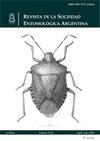Efficacy of three local isolates of entomopathogenic nematodes against the tomato leafminer, Tuta absoluta (Meyrick)
IF 0.5
4区 农林科学
Q4 ENTOMOLOGY
引用次数: 1
Abstract
The tomato leafminer, Tuta absoluta (Meyrick) a key pest of tomato both in greenhouses and open-fields, has spread rapidly throughout Iran. The efficiency of native isolates of three species of entomopathogenic nematodes (Steinernema feltiae, S. carpocapsae, Heterorhabditis bacteriophora) was evaluated against the tomato leafminer, T. absoluta larvae (outside leaf and inside galleries), and pupae at various concentrations and times in laboratory conditions. Experiments were conducted at 25 ± 2ºC, 65 ± 5% RH, and 16L:8D h photoperiod. S. feltiae nematode caused the highest mortality for larvae outside the gallery (53.61%), followed by 45% mortality for larvae inside galleries, and lowest mortality for pupae (3.88%). The effect of infective juveniles (IJ) and exposure time (ET) on larval mortality in different treatments showed a significant (P< 0.01) relationship between IJ and ET and their interactions. Mortality of the T. absoluta larvae and pupae rose with more IJ and longer exposure time. The LC50 for, S. feltiae, S. carpocapsae and H. bacteriophora were 156.01, 225.13, and 317.66 IJs/ml for the second instar larvae of T. absoluta (outside the gallery), 296.31, 305.23 and 320.66 IJs/ml for inside gallery, respectively. Therefore, S. feltiae was a more effective species and can be suggested for complementary studies for finding a suitable biocontrol agent of the pest.3株地方分离的昆虫病原线虫对番茄叶螨的防治效果
番茄潜叶虫Tuta absoluta(Meyrick)是温室和空地上番茄的主要害虫,已在伊朗各地迅速传播。在实验室条件下,评估了三种昆虫病原线虫(Steinerma feltiae、S.carpccapsae、Heterorhambditis bacterophora)的本地分离株在不同浓度和时间下对番茄潜叶虫、绝对T.absoluta幼虫(叶外和廊内)和蛹的有效性。实验在25±2ºC、65±5%相对湿度和16L:8D h光周期下进行。细条线虫对廊外幼虫的死亡率最高(53.61%),其次是廊内幼虫的死亡率为45%,对蛹的死亡率最低(3.88%)。绝对T.absoluta幼虫和蛹的死亡率随着IJ的增加和暴露时间的延长而增加。绝对T.absoluta二龄幼虫(廊外)的LC50分别为156.01、225.13和317.66 IJs/ml,廊内分别为296.31、305.23和320.66 IJ/ml。因此,S.feltiae是一个更有效的物种,可以建议进行补充研究,以寻找合适的害虫生物防治剂。
本文章由计算机程序翻译,如有差异,请以英文原文为准。
求助全文
约1分钟内获得全文
求助全文
来源期刊

Revista De La Sociedad Entomologica Argentina
Agricultural and Biological Sciences-Insect Science
CiteScore
0.80
自引率
20.00%
发文量
31
审稿时长
20 weeks
 求助内容:
求助内容: 应助结果提醒方式:
应助结果提醒方式:


